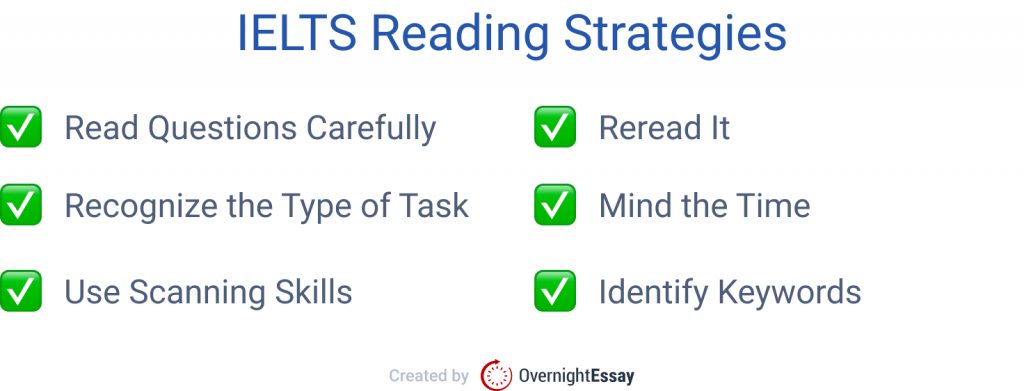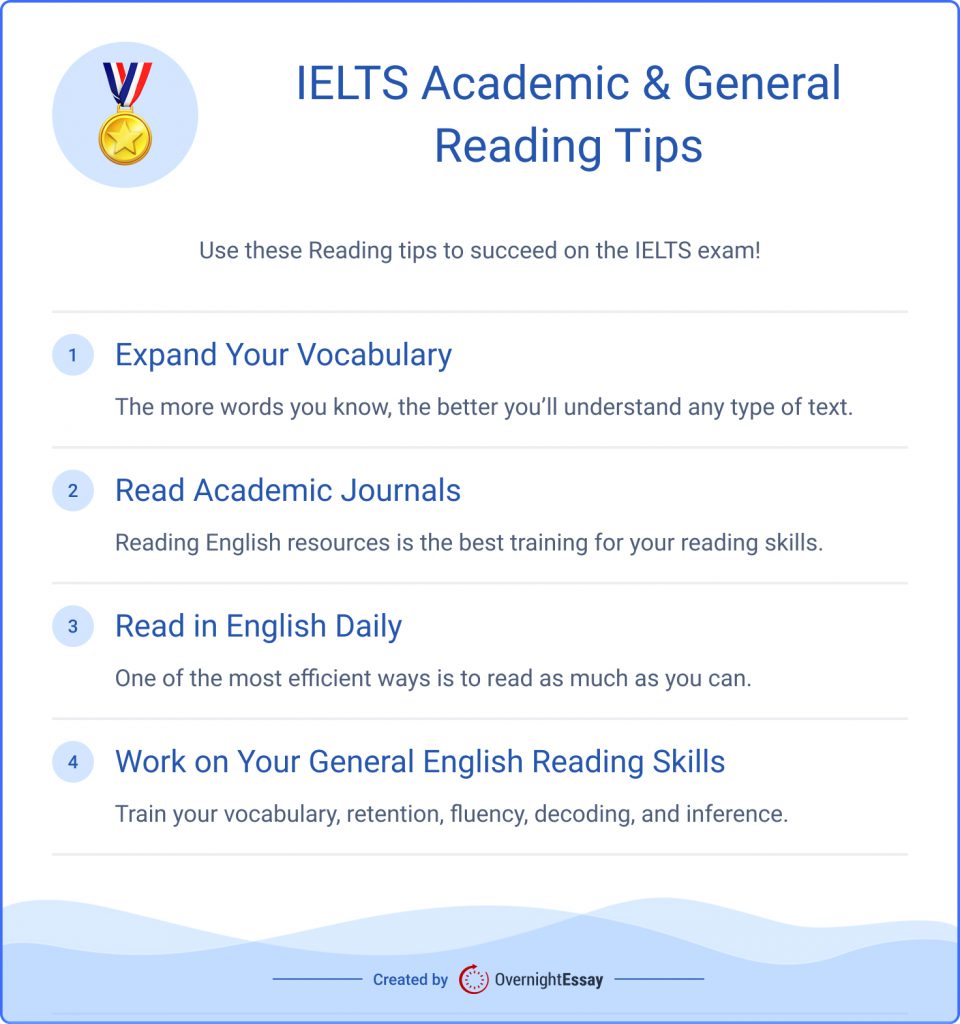IELTS is not an easy exam. It consists of several parts, one of which is reading. The reading part requires a lot of concentration and tests your ability to work with texts. While it may seem complicated to score high in the reading part, it is not impossible with some practice. In this article, we will introduce some IELTS reading strategies and talk about some tips. Enjoy!

📝 IELTS Reading: Test Format
IELTS Academic Reading Format
The Academic Reading section consists of three long texts and 40 questions in total. The texts can vary from descriptive to factual or analytical. The articles are usually taken from books, magazines, or newspapers. They are suitable for people who do not specialize in certain areas but plan to enter the university or seek professional registration.
The participants have 60 minutes to complete this part. Each exam question is worth one mark.
Question Types
IELTS General Reading Format
The General Reading section is similar to the Academic Reading section in terms of the format. The articles are usually taken from newspapers, magazines, or books, advertisements. These materials you can easily encounter in everyday English conversations.
🗓️ IELTS Reading Strategies
IELTS Reading Strategy #1: Read Questions Carefully
To score well in the IELTS exam, you’ll need to read all the instructions carefully. Pay attention to details, see how many words you need to use and how much time you need to answer each question. If you misread the instruction, you may lose marks. Most of the tasks look similar at first glance, and you will recognize them instantly. However, it is always good to pay attention to details to avoid mistakes.
IELTS Reading Strategy #2: Recognize What Type of Task It Is
First, read the question to understand it. Try to identify the type of question and remember the techniques and tips you have learned to solve it. Once you identify what type of question is in front of you, you can quickly think of a better way to approach it.
IELTS Reading Strategy #3: Use Your Scanning Skills
Before getting into a question, it can be helpful to skim the text once to get the overall idea. After you start working with questions, you still don’t have to stop and read into the text’s details. Getting the general idea of the passage is more important in the skimming part. Finding the topic sentence can help you understand the main idea of the text. It is usually the first sentence of the paragraph; however, sometimes, it can be found at the end. Understanding the whole passage is not a necessity. Your objective is to answer as many questions as possible within the given time.
IELTS Reading Strategy #4: Read It Once Again
Some questions can be tricky. If you think that you have found an answer to one of the questions, it will be good to go back and read the whole paragraph or one- two sentence before and after the sentence that contains your answer. It will help you to avoid unnecessary mistakes.
IELTS Reading Strategy #5: One Question Isn’t Worth Too Much Time
You have to remember that you have limited time during your exam. If you want to answer as many questions as possible, you may want to keep several things in mind:
- Fill in the answer sheet as you go. The answer sheet is important, as only the answers recorded there will be considered and marked.
- Don’t get stuck on one question. If you can’t answer the question – move on. If you have time, you can answer it later.
- Only skim the text before starting to answer the questions. Do not waste your time reading and understanding the text. If you want to get the overall idea, you can just skim it and go to the question section.
IELTS Reading Strategy #6: Identify a Keyword in the Task
When you read the question, try to locate the keyword or phrase. It will be much easier to find the answer to the question in the text. Underlining the most important phrases or words while skimming the passage can also save a lot of time.
💡 IELTS Reading Tips

IELTS Academic Reading Tips
In this section, you will find excellent IELTS Academic Reading tips that help you on the exam. Let’s dive in!
IELTS Academic Reading Tip #1: Expand Your Academic Vocabulary
If you are taking an Academic Reading test and want to score well, vocabulary should be at the top of your priority list. The more words you have stored, the easier it is to understand any text. The IELTS exam uses a wide range of vocabulary, and it may cause some difficulty. Here are some tips:
- Write down new words or expressions and their definition
- Put these words/expressions into a sentence. Contextualize them
- Look for collocations
- Look for antonyms/synonyms
- Check the word forms (verb, noun, adjective, adverb, etc.)
IELTS Academic Reading Tip #2: Read Professional and Academic Journals
To prepare for the Reading part, you should consider reading seriously and practice as much as you can. Resources that you use while preparing for the exam are important. Getting into academic literature can help you to improve your reading skills greatly. You can use websites such as:
IELTS General Reading Tips
Now you’re familiar with most of the tricks for the IELTS reading part. So, let’s have a look at IELTS General Reading tips. Let’s go!
IELTS General Reading Tip #1: Read English Sources Daily
One of the most efficient ways to improve your English is to read as much and as often as you can. Reading news is especially helpful. If you read a formal new website, you start to see how sentences work and how they are put together. When you read some more light-hearted magazines, you get the grasp of a less formal language. Here are some websites that you can use to practice your reading:
If you read at least one article per day from these magazines, you will be surprised to see the progress.
IELTS General Reading Tip #2: Work on Your General English Reading Skills
Reading skills show a person’s capacity to understand, comprehend, and interpret things written in the text. They encompass several aspects that come together and develop your overall literacy. Good reading skills require good vocabulary, retention, fluency, decoding, and inference. There are different ways to improve your skills. You may consider the following steps:
- Stay consistent
- Set reading goals
- Take notes while reading
- Summarize what you have read
- Preview/scan over the texts you read
IELTS is not an easy exam, and to score well, you need to be prepared. The reading part is not an exception. However, if you take time to prepare and plan, it becomes much more manageable. Keep in mind the IELTS reading strategies and insides mentioned in this article, and you won’t have to struggle while you are preparing for the exam!